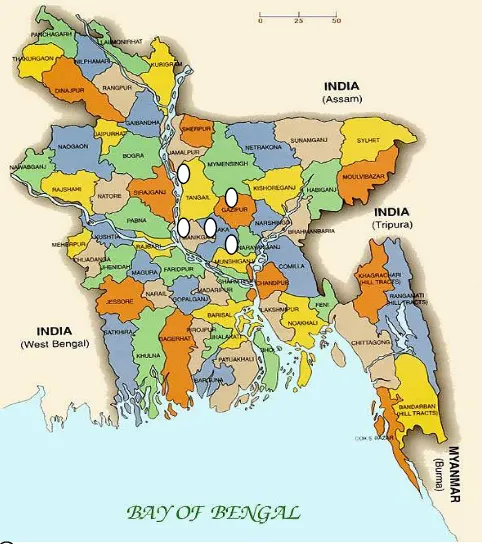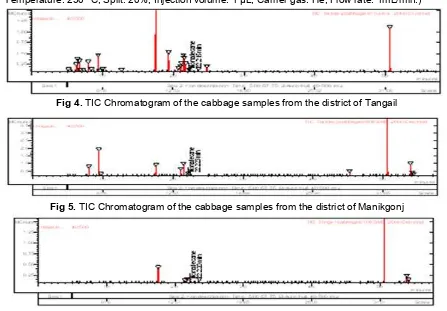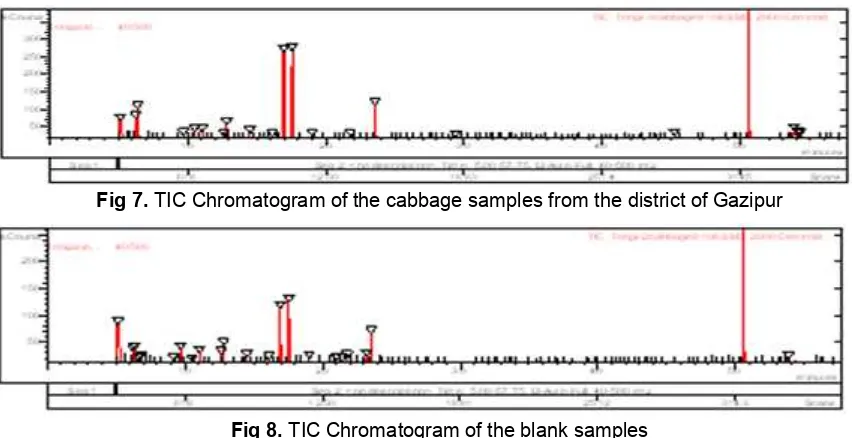* Corresponding author. Tel: +88-028628913 Fax:+88-028617946; Email: [email protected]
SEPARATION AND IDENTIFICATION OF NORMAL HYDROCARBON, NONADECANE IN
THE CABBAGE VEGETABLES SAMPLES (
Brassica oleracea VAR. CAPITATA F. ALBA
) BY
GAS CHROMATOGRAPHY–MASS SPECTROMETRY
M. Amzad Hossain*, S. M. Salehuddin and M. J. Kabir
Chemistry Division, Atomic Energy Centre, GPO Box 164, Ramna, Dhaka-1000, Bangladesh
Received 7 May 2008; Accepted 24 May 2008
ABSTRACT
Toxic normal hydrocarbon (NH), nonadecane in the methanolic extract of the whole of cabbage samples collected from different districts of Bangladesh was analyzed by GC-MS. It was observed that NH deposition on the samples takes place in different morphological parts of the biological materials. The NH, nonadecane, was found in the cabbage samples collected from the highway road side by the extraction of methanol. The identification and quantification of the title compounds have not been reported previously in the cabbage sample.
Keywords: Cabbage;brassica oleracea var. capitata f. alba; quantification; normal hydrocarbon, nonadecane, GC-MS.
INTRODUCTION
It is well to known that most of the polynuclear aromatic hydrocarbons, polychlorinated biphenyls and cyclic organochlorines are toxic, carinogenic and mutagenic [1-9]. These organocompounds are produced worldwide on an enormous scale. The common features of these organic chemical pollutants are high hydrophobicity and resistance to environmental degradation [10]. These pollutants can be easily found in the samples of environmental interest, e.g. in the atmospheric air, water, soil and sediments [1,4,9-17] and in foodstuffs [18-22].
Toxicological data are not yet available for the organic contaminants generally found in water. Of the 298 volatile organic compounds identified in drinking water, the United States National Academy of Sciences selected 129, including 55 pesticides, as being of concern to the public health [23].
Normal hydrocarbons, e. g. n-decane, n-undecane, n-dodecane, n-tetradecane found in drinking water have been recognised as potent promoters in carcinogenesis [24]. Normal hydrocarbons of higher molecular weight such as C19H40-C35H72 present in the atmosphere of the working place of Paraffin Extraction Industries have shown the carcinogenesis effect. For example, in this industrial area, 1393 out of 100,000 workers and 340 inhabitants out of 100,000 population in the surrounding area were found to suffer from skin-cancer disease [25]. These findings on high molecular weight hydrocarbons indicate that hydrocarbon contamination of food articles should be carefully evaluated in order to find its health implications.
Scientific data are very much lacking on the concentration level that may cause acute toxicity and the maximum admissible level of the individual constituents of petroleum oils in the environment, which are not
harmful with long term or continuous exposure. Smith reported [26] that the phytotoxic effect of hydrocarbons on terrestrial plants increases in the order: straight chain paraffins, olefins, cycloparaffins, aromatics, etc.
The aim of the present study is to identify and quantify the highly toxic normal hydrocarbon, nonadecane in the methanolic extract isolated from the whole cabbage sample by GC-MS.
EXPERIMENTAL
Chemicals
Methanol and dichloromethane (Merck, Germany), solvents used in this experiment were of HPLC grade. Anhydrous sodium sulphate (Merck, Germany) was cleaned by heating at 200 °C before use. Silica gel (60-120 mesh, Merck, Germany) activated at 400 °C for 12 h prior to use. Nonadecane of (Sigma-Aldrich) was used as standard in the present study.
Plant material
The cabbage samples were collected from the nearest different districts of Dhaka Metropolitan City (DMC), Dhaka, Bangladesh in January 2006 and initially identified by morphological features and database present in the library at the herbarium of the Department of Biology, University of Dhaka, Dhaka, Bangladesh.
Isolation and preparation of crude extracts
M. Amzad Hossainet al. cleanup column (5 cm), which was then topped with 1.5 cm of anhydrous sodium sulfate. Ten milliliters of dichloromethane was added to wash the sodium sulfate and the silica gel. The dried 1 mL sample was then transferred into the column, the vessel was rinsed twice with 2 mL dichloromethane, which was also added to the column. Fifty milliliters of dichloromethane was added to the column and allowed to flow through the column at a rate of 3–5 mL/min, and the eluent was collected. The collected eluent from the cleanup procedure was reconcentrated to 1 mL with K-D concentrator.
GC-MS analysis
The GC-MS analysis of the methanolic crude extract of cabbage samples was performed using a Varian GC-MS (Model Varian CP 3800) equipped with a VF-5 fused silica capillary column (30 m x 0.25 i. d., film thickness 0.25 m). For GC-MS detection, an electron ionization system with ionization energy of 70 eV was used. Helium gas was used as a carrier gas at a constant flow rate of 1 mL/min. Injector and mass transfer line temperature were set at 250 and 300 °C, respectively. The oven temperature was programmed from 50 to 200 at 8 °C/min, and then held isothermal for 20 min. and finally raised to 300 °C at 10 °C/min. Diluted samples (1/100, v/v, in methanol) of 1 L were manually injected in the split less mode. Identification of compounds of the methanolic crude extract was based on GC retention time on VF-5 capillary column, computer matching of mass spectra with standards (Mainlab, Replib and Tutorial data of GC-MS systems) and, whenever possible, by co-injection with authentic compounds [27].
Preparation of standard
Calibration graphs for the samples treated according to the described analytical procedure were made using the SIM mode. Different concentrations of nonadecane (0.5, 1, 5 and 100 ng/L) were used for calibration curve.
RESULT AND DISCUSSION
Bangladesh is an agricultural country. Vegetables, crops and fruits are grown here in plenty, mainly in the winter season. Cabbage is one of the most commonly used as vegetables because it is cheap and available all over the Bangladesh throughout the winter season. Again, to use it for other seasons, sometimes villagers harvest the cabbage samples, cut it into small pieces and dry it under methanolic extract isolated from the whole cabbage sample by GC-MS.
The dried cabbage powder sample was extracted with methanol and filtered. The filtrate was cleaned up to remove the vegetable fats and oily or gammy compounds. The methanol solvent was evaporated to dryness by Kuderna-Danish evaporator. From the
concentrated extract only 1 μL was injected to the GC -MS. We have collected cabbage samples from some nearest districts of Dhaka Metropolitan City (DMC) in the month of January 2006 Fig. 1. We know that the chemical composition of all kinds of fruits, vegetables and plants depends on the geographical distribution such as temperature, weather, soil condition etc [28].
Sample collection site
Fig 2. Calibration curve of nonadecane standard (Column: VF-5 (l. 30 m, i.d. 0.25, film thickness 0.25 µm); delay: 5 min; Temperature Program: 50°C(1)—› 200 °C (8 °C/min) —›300oC (10 °C/min); Injector Temperature: 250 °C; Split: 20%; Injection volume: 1 µL; Carrier gas: He; Flow rate: 1mL/min.)
The separation, identification and quantitative determination of nonadecane were done by external calibration curve method. The calibration curve already prepared with known concentration of nonadecane is detailed below Fig 2. Standard curve for nondecane generated by plotting the area of four spots vs. the concentration, gave high correlation coefficients.
The nonadecane is identified by comparing their retention time (RT) on the total ion chromatogram (TIC) of the substance in the samples Fig. 3-8 with that of the respective compound in a standard solution analyzed under the same conditions. The existing GC-MS/MS library database (NIST) shows the RT of nonadecane from the cabbage samples in Fig. 3-8as -22.242 (base peak, 57.1).
Fig 3. TIC Chromatogram of the cabbage samples from the Talola, Dhaka (Column: VF-5 (l. 30m, i.d. 0.25, film thickness 0.25 µm); delay: 5 min; Temperature Program: 50 °C(1)—› 200oC (8 °C/min) —›300 °C (10 °C/min); Injector Temperature: 250 °C; Split: 20%; Injection volume: 1 µL; Carrier gas: He; Flow rate: 1mL/min.)
Fig 4. TIC Chromatogram of the cabbage samples from the district of Tangail
Fig 5. TIC Chromatogram of the cabbage samples from the district of Manikgonj
M. Amzad Hossainet al.
Fig 7. TIC Chromatogram of the cabbage samples from the district of Gazipur
Fig 8. TIC Chromatogram of the blank samples
Table 1. Concentration of nonadecane in the five cabbage samples from the nearest district of DMC, Bangladesh
Sl. No Cabbage samples, District
Location Concentration (mg/g) 1 Taltola, Dhaka Highway road side 7.665 μg/g 2 Tangail Road side 0.242 μg/g 3 Manikgonj Highway road side 3.817 μg/g 4 Tongi, Dhaka Away from road side ND* 5 Gazipur Away road side ND*
6 Blank - ND*
*ND=Not detectable
The methanol crude extract contains a complex mixture consisting of mainly flavonoids, alkaloids, caffice acid, oxygenated mono, di and triterpenes, and mono and sesqueterpene hydrocarbons [29].
Firstly for our experiment, we have taken five cabbage samples, which were collected from the nearest district of the DMC. The collected samples were cultivated and harvested during the winter season. The concentration of nonadecane, a toxic normal hydrocarbon, in the five cabbage samples were measured by GC-MS and the results calculated from the external curve method Table-1.
Linear responses were achieved for nonadecane in the concentration range for the cabbage samples with the values 7.665, 0.242, 3.817, ND and ND µg/g respectively. Over this concentration range, the linear regression analysis of peak areas (y) in function of concentration (x), calculated by least square method, leads to the following equations: y = 16,276x +4,168 (r2 = 0.99) for nonadecane.
From experiment we have found that three cabbage samples out of five contain toxic nonadecanebut the concentration is low to reach the permissible limit [30]. Although the method had the low detection limits, no analytes were detected in the blank
mixture samples. We have also seen that the NHs contamination in vegetables, fruits and plants is mainly depended on the sample collection site. In the road side, the cabbage samples are normally contaminated by the NHs, but away from the roadside, no NHs detected by the GC-MS in our experiment Table 1. So from our experiment we conclude that the cabbage sample was contaminated mainly by the vehicle exhaust or coal tar.
CONCLUSION
The method, combination of liquid-phase extraction with gas chromatographic–mass spectrometric towards analysis of trace normal hydrocarbon, nonadecane in cabbage samples, was reported for the first time by the authors in our laboratory. The method has favorable extraction effect and higher enrichment factor, especially to normal hydrocarbons. This reliable, rapid and convenient method was applied successfully to determine other normal hydrocarbons and also polycyclic aromatic hydrocarbons in the cabbage and other biological sample. From the data of nonadecane, it is confirmed that the vehicular emission is the major source of NHs and it has polluted our environment and foodstuff.
ACKNOWLEDGEMENT
M. Amzad Hossainet al.
REFERENCES
1. Hawkins,W.E., Walker, W.W., Overstreet, R.M., Lytle, J.S., and Lytle, T.F., 1990, Sci. Total Environ., 94, 155-163.
2. Devillers, J., and Chambon, P., 1986, Bull Environ. Contam. Toxicol., 37, 599-603.
3. Vander Heijdern, C.A., and Van Kreijl C.F., 1985, Sci. Total Environ., 47, 479-483.
4. Kirso, U., Paalme, L., Voll, M., Urbas, E., and Irha, N., 1990, Marine Chem., 30, 337-341.
5. Devillers, J., 1988, Sci. Total Environ., 76, 79-82. 6. Zitko, V., Mcintyre, A.D., Mill, C.F., 1975, Ecological
Toxicology Research, Pelnum Press, New York, London, 82.
7. Sach, M.A., and Casida J.E., 1972, Advance in Pesticide Science, H. Gishuler (Ed.), Paragamon, Oxford, Part-3, 562.
8. Grushko, Y.M., 1982, Verdnic Organisiskie Saidinenia V Promishlennikh Stosnikh Vodakh, Khimia, Leningard.
9. Ernst, W., Boon, J.P., and Weber, K. In: Salomons, W., Bayne, B. L., Duursma, E. K. and Forstner, U. (Eds), 1988, Pollution of the North Sea an assessment, Springer-Verlag, Berlin, Heidelberg. 10. Boon, J.P., Everaarts, J.M., Kastoro, W.W., Razak,
H., Sumanta, I., Nelissen, P.H., Stefels, and Hillerbrand, M.T.J., 1989, Netherland J. Sea Research, 23(4), 427-433.
11. Cary J.H., Ongley, E.D. and Nagy, E., 1990, Sci Total Environ., 97/98, 69-74.
12. Saliot, A., Bigot, M., Boulonbassi, I., Lipatoo, E., Qiu Y.J., and Scribe, P., 1990, Sci Total Environ., 97/98, 55-64.
13. Duinker, J.C., Hillebrand, M.T.J., Zeinstra, T., and Boon, J.P., 1989, Aquatic Mammales, 15(37), 95-101.
14. Morselli, L., and Zappoli, S., 1988, Sci Total Environ., 73, 257-264.
15. Bailey, J.C., Gunary, K., Schimidl, B., and Wilams, M.L., 1990, Sci Total Environ., 93, 199-204.
16. Zhao, Z.H., Quan, W.Y., and Tian, D.H., Sci Total Environ., 92, 145-150.
17. Jones, K.C., Grimmer, G., Jacob, J., and Johnston, A.E., 1989, Sci Total Environ., 78, 117-123.
18. Sivaswany, S.N., Balachandran, B., and Sivaramakrishnan, V.M., 2006, Curr. Sic., 75(8), 580-584.
19. Boon, J.P., Oudejans, R.C.H.M., and Duinker, J.C., 1984, Com. Biochem. Physiol., 79c, 131-138. 20. Robards, K., Food Addit. Contam., 1990, 7(2),
143-151.
21. Gilbert, J., and Startin, J.R., 1981, J. Chromatogr., 205, 434-441.
22. Varanasi, U., Stein, J.E., Nishimoto, M., Reichert, W.L., and Collier, T.K., 2005, Envron. Health Prspectives, 71, 203-211.
23. Bedding, N.D., McIntyre, A.E., and Lester, J.N., 1986, Sci Total Environ., 27, 163-166.
24. Clark, R.M., Goodrich, J.A., and Deinninger, R.A., 1986, Sci Total Environ., 53, 153-159.
25. Lazareva, N.V., (Ed).,1976, Vrednic Bishistba V Promishlennochi I, Khimia, Leningard.
26. Smith, A.N., 1971, Seminar Proceedings held at Avemore, Inverness-Shire Scotland, London. 27. Lawless L., 1999, The Illustrated Encyclopedia of
essential oils. Element books ltd’. Shaftesburg, UK. 28. Haward, J.W., and Fazio, T., 1980, Quantification
of PAHs in the foodstuff. J. Assoc Off Anal Chem, 1963, 1077-1085.
29. Simnonish, S., and Hites, R., 1995, Environ. Sci. Technol., 29, 2905-2908.


